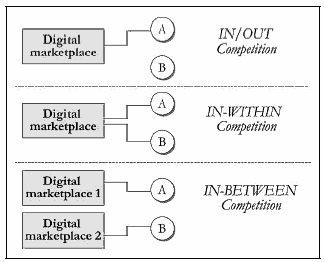Logistic, relational and cognitive processes are profoundly affected by infomediation services, but these changes do not only involve the competitive process of participating firms.
Since they pervasively impact on value aggregations, the competitiveness of infomediaries is also affected.
The process of competitive selection, led by the adoption of b2b digital services, takes place at different levels (see Figure 5).

Figure 5 Different Levels of Competitive Selection, Through Infomediation, in B2B Digital Markets
This process is called inout competition. The use of digital services changes the established competitive balance of the market, differentiating the offer among companies that join digital marketplaces from those that do not.
On a second level, companies participating in the same marketplace can obtain different competitive impacts according to their degree of integration in online and offline activities.
The in-within level of competition among firms in a digital marketplace depends on the consistency and fit between services delivered by the infomediaries and the company-specific resources and objectives.
A third level of competition, called in-between competition, can also take place between companies that participate in different marketplaces.
For example, two companies which operate under the same conditions in two different marketplaces and benefit from two different sets of services will probably gain different competitive advantages.
This last level of selection shifts attention to another dimension that directly concerns infomediaries.
If their services influence the competitive advantage of user companies, this enhancing capability also becomes the principal driver of their own competitiveness.
In fact, a company probably decides to participate in a digital marketplace on the basis of the services it delivers.
This means that an infomediary in b2b digital markets will gain a competitive advantage only when participants benefit from the services it delivers.
The capability of an infomediary to compete horizontally against its competitors is structurally linked to its capacity to enhance user company competitiveness.
This phenomenon of competitive co-evolution, enhanced by digital platform features, links the competitive dynamics of both service suppliers and users in b2b digital marketplaces, thereby designing different co-evolution paths.
In this sense, digital marketplaces tend to evolve in relation to the competitive effects it generates through service delivery.
During the early stages of evolution, infomediaries face scarce liquidity in digital markets that represent only a secondary source for company exchanges.
To break down company entry barriers, market makers generally choose to provide transaction-enabling services like order matching, catalogue searching, and aggregation of orders that improve visibility and logistic management.
In this way they try to attract new companies.
When new participants join the virtual environment and the marketplace reaches critical mass, market liquidity increases and participants benefit not only from visibility and logistic services but also from the positive impact on trust resources.
In this phase, infomediaries organise primary markets for many companies.
At the stage of maximum growth, virtual trading communities represent the only market for a large number of participants.
The new challenge market makers now have to face is retaining users rather than finding new ones.
Companies that manage marketplaces need to construct a complex system of networking in order to activate that virtuous circle of knowledge creation described above.
To sum up, providing digital services in b2b marketplaces does not only mean managing the delivery of a complex set of activities but also having a profound influence on the competitive dynamics of businesses.
This area of research will probably attract the attention of academic and business communities in the near future.